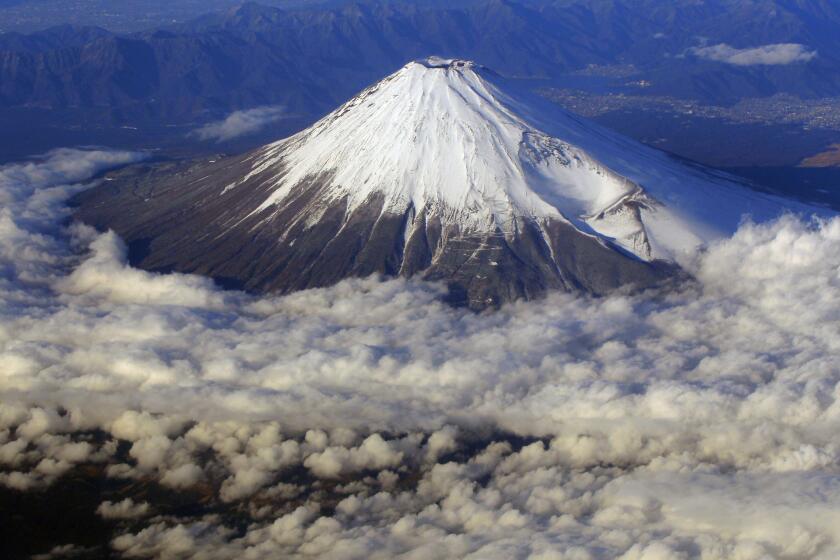Cubans Find Tourism Is the Best Way to Make a Buck
Communism failed to produce anything resembling a workers’ paradise in the factories of the old Soviet Union or the rice paddies of Asia. But for those employed at Cuba’s palm-fringed Caribbean resorts, work is relatively pleasant -- at least compared to the drab daily life in the rest of the country.
They spend their 40-hour workweek in the air-conditioned comfort of high-end hotels, tidying elegant rooms for foreign tourists, laying out lavish buffets and serving fruit-festooned rum drinks at poolside.
They are paid twice as much as the average Cuban laborer and earn dollar tips that give them much more buying power than blue-collar comrades -- or respected brethren in law, medicine and education.
The only real letdown for those working in luxury tourism is that they have to go home at the end of the day.
“It’s very upsetting to see so much food being wasted when most people on the mainland don’t have enough to eat,” said one waiter at the five-star Melia Cayo Coco, located on this island just north of Cuba’s main island, nervously watching over his shoulder to be sure no one overheard.
The contrast between the thriving tourism trade and the living standards of most Cubans appears to be eroding what little rank-and-file support remains for the ideals of Fidel Castro’s revolution. Today’s proletariat is mostly concerned with making money.
From the quartet of college-educated professionals serenading lunchtime diners clad in wet swimsuits to the bartenders mixing cocktails in their beachfront shacks, Cubans say they are attracted to the tourist trade by the chance to earn dollar tips.
Jesus Delgado, 30, who, like all Cayo Coco workers, commutes from the mainland by bus 70 minutes each way, grew up wanting to be a doctor. Instead, he waits on tables.
“Things are more expensive now, so money is more important,” he said, adding that his wife and mother also depend on his $13 monthly income and as much as $10 a day in tips. As a doctor, he would earn only $15 to $20 a month.
In the dozen years since the Soviet Union collapsed and billions in aid and oil subsidies to Cuba disappeared, university enrollment has dropped by more than half and many state workers are moonlighting in industries that serve foreigners in order to earn dollars.
Castro signaled second thoughts in July on the growing “dollarization” of the economy, ordering all state-owned companies to turn over their dollars for convertible pesos. Some industry analysts saw the move as an expression of the Communist leader’s concern that his ideals were being corrupted by hedonistic tourists and the obsession with making a buck.
“He sees what it is doing to the youth of the country. It’s creating a class of dropouts because young people have no other hope for the future,” said Art Padilla, a North Carolina State University professor of management who recently studied Cuba’s tourism industry on a Fulbright scholarship.
Padilla said he believes Castro reluctantly allowed his government to resurrect tourism a decade ago, when the loss of Soviet aid left other industries a shambles.
“Some may see a contaminating effect, but long ago they made clear that it’s a cost they’re willing to accept,” Philip Peters of the Lexington Institute, a scholar and frequent visitor, said of the official Cuban view of tourism.
Cuban officials say the average wage in the country amounts to about $10 a month. Every Cuban also receives food rations, which consist mostly of starches, free health care and education. But the rations cover less than half of an adult’s daily caloric needs, and most food on the open market sells at close to U.S. prices. As much as $1 billion in family remittances sent by Cubans abroad tides over some of the population. Those without foreign beneficiaries are increasingly turning to the resort industry to make ends meet.
The Cuban business weekly Opciones estimates that the tourist industry accounted for 40% of Cuba’s hard-currency earnings in 2001, up from 4% in 1990.
The government earns additional millions in visa fees and airport departure taxes -- a sum that consultant Maria Werlau of Chatham, N.J., said exceeded $50 million over the last three years.
Tourism has overtaken sugar, rum, tobacco, nickel and even foreign remittances as the No. 1 hard-currency earner. In late June, Cuba received its millionth tourist for the year, a month earlier than in any previous year. That puts Cuba on track to host a record 2 million tourists this year despite a crackdown on dissidents in March and the execution of three hijackers a month later that angered the sources of the most tourists: Canada, Mexico and the 15-nation European Union.
Some industry analysts say that service is shoddy. This also hurts the future of Cuba’s tourist industry, particularly at budget “all-inclusives,” where visitors pay a flat rate for airfare, food, drinks, activities and lodging. Increasingly, visitors are leaving with a diminished impression of Cuba and some irritation at tip-mongering.
“You’re spared here. You don’t see anything of the country -- it’s just a resort,” said Emma Sheppard, a honeymooner from Brampton, Canada. “But when we went to Havana, we got to see how people really live.”
She said she was accosted by peddlers and beggars throughout the day trip to the capital.
Although she found the resort staff caring, she was disappointed by the monotonous food and the realization that, although gratuities were supposed to be included, maids, waiters and entertainers relied heavily on tips for their income.
A veteran tour company executive from the Swiss-based Globus and Cosmos network was even more critical after conducting an undercover quality inspection at a resort in Varadero, one of Cuba’s main resort areas, where tipping isn’t allowed. She found the staff negligent, the rooms run down and the food so bland as to be called tragic.
“The general attitude was that they just wanted your money, nothing more, nothing less,” the inspector wrote to the U.S.-Cuba Trade and Economic Council, which commissioned the audit.
Most Cubans aren’t permitted in the resorts. But outside, they hound tourists for money.
In Havana, a trumpeter seated on the Malecon embankment playing the theme from “The Godfather” ceased in mid-note to demand a dollar from a tourist who had just snapped his picture.
A troupe of street artists on stilts parading noisily down busy Obispo Street in the capital’s old town shoved hats and tambourines at anyone passing. In the quaint iron-grilled doorway of a restored villa near the seaport, three women decked out in colorful African dress smiled and flirted with camera-toting visitors until they took the trio’s pictures. Then the women shouted in unison: “Hey lady, hey mister, give me one dollar!”
Cuba legalized dollar holdings in 1993, but only paper money is circulated. So the minimum tip or handout is a dollar, and that has become the price of almost every service, from luggage handling to mariachi serenades.
At a wooden gazebo in Cayo Coco where visitors get their beach towels and make appointments for horseback riding, salsa lessons or a massage, Lester Fernandez said he earns $20 to $30 a week in tips on top of his $20 monthly salary. Until a year ago, he had been studying dentistry.
“This way I can help my family more,” the 23-year-old said. He supports his grandmother and a brother who is in the army.
Guests say they have been quietly encouraged by some resort staff to make the drive across the causeway to the mainland city of Moron to see “the real Cuba.”
“I knew it was a poor country, but never realized to what extent,” said Russell Docking, a newlywed from Cambridge, England. “Also the fear in people.... It’s not until you come to a Communist country that you see how much fear they have to live with. It makes you appreciate how well you’ve got it.”
Sign up for The Wild
We’ll help you find the best places to hike, bike and run, as well as the perfect silent spots for meditation and yoga.
You may occasionally receive promotional content from the Los Angeles Times.




